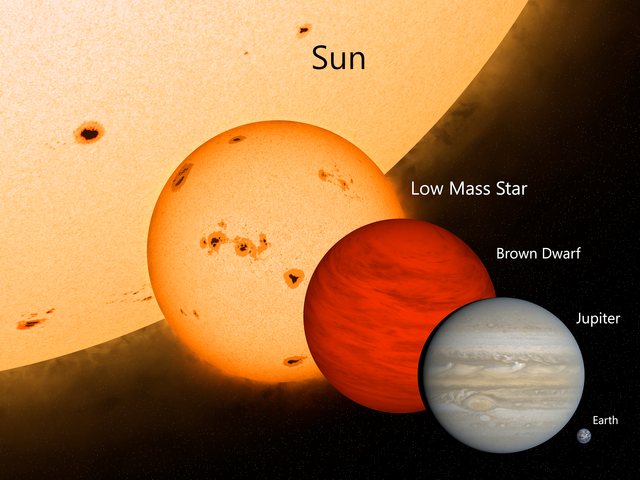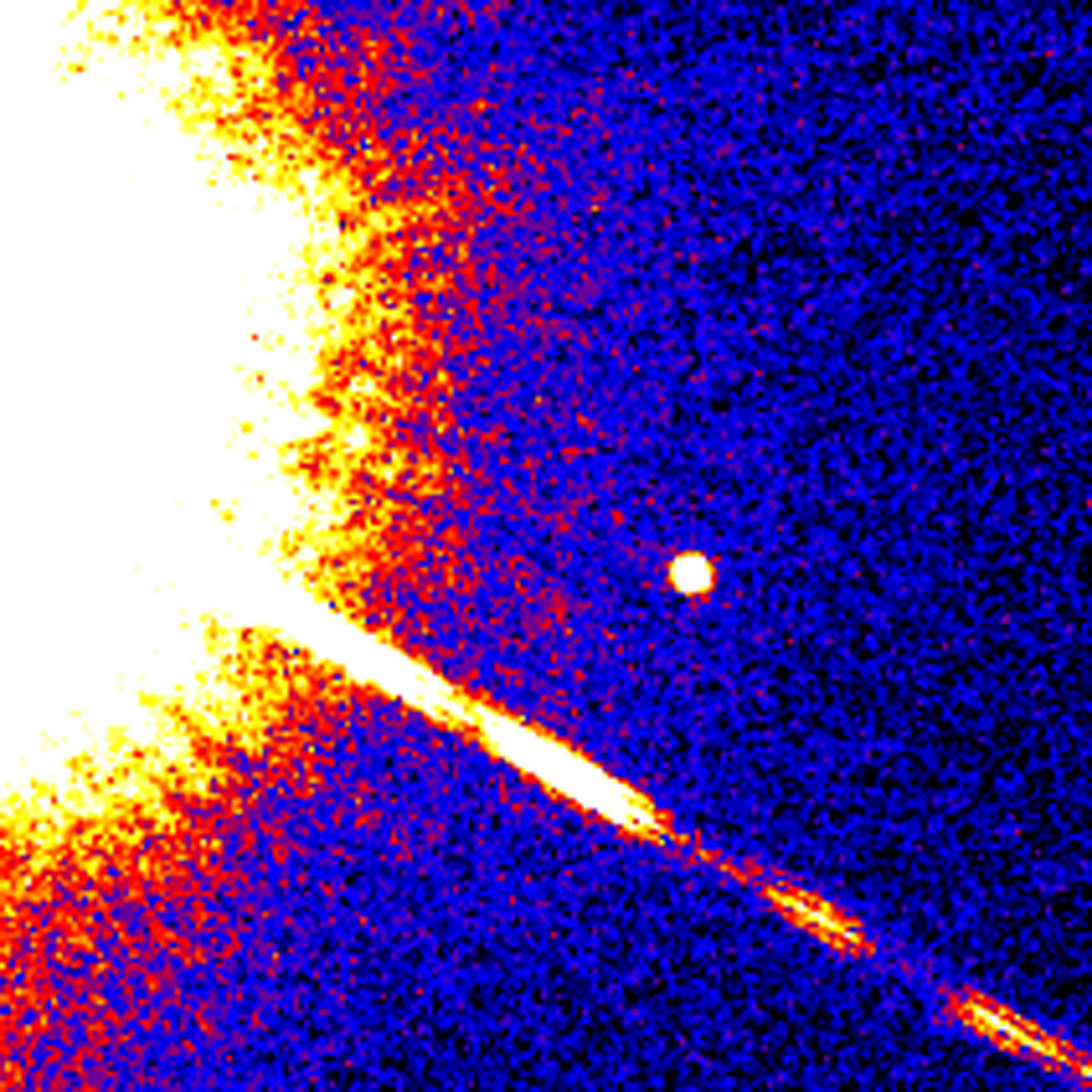
Image 1 Caption: A size comparison (at least roughly to-scale) for astro-bodies in decreasing order by mass from the Sun to the Earth:
- Sun:
solar mass M_☉ = 1.98855*10**30 kg
= 1047.34864(17) M_Jup
(see Wikipedia:
Jupiter Mass: Current best estimates).
- red dwarf
in artist's conception:
Just considering
M dwarfs,
the stellar mass range is
∼ 0.08 -- 0.6 M_☉
(i.e., ∼ 80 -- 630 M_Jup).
Considering M dwarfs
and K dwarfs,
the stellar mass range is
∼ 0.08 -- 0.8 M_☉
(i.e., ∼ 80 -- 840 M_Jup).
For reference, see Wikipedia: Red dwarf;
Wikipedia: Red dwarf:
Description and characteristics.
- brown dwarf
in artist's conception:
The mass range is
∼ 13 -- 80 M_Jup
(i.e., ∼ 0.012 -- 0.08 M_☉)
(see Wikipedia: Brown dwarf).
- Jupiter:
Jupiter mass M_Jup = 1.89813*10**27 kg
= 9.547919*10**(-4) M_☉ (≅ 1/1000 M_☉)
= 3.1782838*10**2 M_⊕ (≅ 300 M_⊕).
- Earth:
Earth mass M_⊕
= 5.9722(6)*10**24 kg
= 3.0033*10**(-6) M_☉
= 3.1464*10**(-3) M_Jup.

Image 2 Caption: "A brown crossbreed Netherland Dwarf domestic rabbit loafing (legs and paw tucked under the body). This particular rabbit's name is Toffu." (Somewhat edited.) Artist conception images of brown dwarfs are so dull, yours truly thought to liven things up with a what a google search finds.
Note, Brown dwarfs are NOT
on the main sequence
(since they NOT doing
hydrogen burning),
but their
effective temperature
(a characteristic or sort-of-average
photospheric temperature)Features of Brown Dwarfs:
and their luminosity
puts them on the
Hertzsprung-Russell (HR) diagram
near the lower right-end of the
main sequence, and so they form
a sort of extension of the
main sequence.
From their internal heat energy, the hottest brown dwarfs may appear on average or orange or red. Cooler ones may appear on average magenta or just dark (Wikipedia: Brown dwarf). Brown dwarfs probably mostly radiate from their internal heat energy in the infrared band (fiducial range 0.7 μm -- 0.1 cm) with only a little in the visible band (fiducial range 0.4--0.7 μm =400--700 nm = 4000--7000 Å) (Wikipedia: Brown dwarf).
In detail, the actual coloration of brown dwarfs may be rather complex since it depends on a mixture electromagnetic radiation (EMR) from internal heat sources and reflected light (if they are in gravitationally bound systems containing stars) and on their chemical composition of their atmospheres.
In fact, brown dwarfs probably have multiple colors which like Solar System gas giants are likely organized in gas giant bands due to convection combined with rotation as is the case for Solar System gas giants. The artist's conception of a brown dwarf in Image 1 shows something a bit like gas giant bands.
What of nuclear burning?
Brown dwarfs too low mass to do nuclear burning of hydrogen (H-1) to helium-4 (He-4) (i.e., hydrogen burning) in their cores which is why they are NOT stars. They can nuclear burn deuterium (D, H-2) for mass ⪆ 13 M_Jup and lithium-7 (Li-7) for mass ⪆ 65 M_Jup.
Brown dwarfs or some of them may have convection throughout their interior, and, if this is the case, they will eventually nuclearly burn in their cores all their deuterium (D, H-2) and lithium-7 (Li-7) (Wikipedia: Brown dwarf). The time scale for burning up all their deuterium (D, H-2) and lithium-7 (Li-7) maybe of order 0.5 Gyr ??? (Wikipedia: Brown dwarf: The lithium test).
The nuclear burning of brown dwarfs provides some of their internal heat energy and the rest is provided by the aforesaid. primordial-radiogenic heat energy.
Ultimately, brown dwarfs will just cool off fovever and probably mostly approach absolute zero T = 0 K in the far future.
Circa 2024, there may be some 100s or 1000s of known brown dwarfs, but there seems NO definite count maybe because distinction between candidate and confirmed brown dwarfs is a moving target (Wikipedia: List of brown dwarfs). Brown dwarfs are hard to discover and confirm because they are so dim.
Circa 2024, it has been estimated that the ratio brown dwarf number to star number in the Milky Way may be of order 1/4. So of order 1/4 may be the best estimate for the observable universe.
Although brown dwarfs may be comparably abundant to stars, their masses are much smaller than stars. Thus, their contribution the mass-energy of the observable universe is small and probably negligible for cosmology.
- They do NOT look interesting insofar as we can imagine them.
- They contribute little as aforesaid to the mass-energy of the observable universe, and so are unimportant for cosmology.
- Because they do NOT eject any material back into space as stars do, they are just quasi-eternal sinks for matter, and thus do NOT contribute to cosmichemical evolution at least on the time scale of the age of the observable universe = 13.797(23) Gyr (Planck 2018).
- They CANNOT have life as we know it, though they might have planets that do, but this is NOT likely to be common (Wikipedia: Brown dwarf: Planets around brown dwarfs; Wikipedia: Brown dwarf: Habitability).
The upshot is that brown dwarfs do little. They just form and cool off forever.
If brown dwarfs did NOT exist, they would NOT have to be invented.
However, since brown dwarfs do exist, they do fill the gap in the continuum of astro-bodies between gas giant planets and small stars. Full understanding of the continuum thus requires understanding brown dwarfs.
The large astro-body
in Image 3
is star
Gliese 229.
The Gliese 229B brown dwarf binary system
consists of substellar companions of
Gliese 229:
i.e., the
Gliese 229B brown dwarf binary system
orbits
Gliese 229.
The
Hubble Space Telescope (HST, 1990--2040?, d = 2.4 m, Cassegrain reflector)
image is from
1995
Nov17.
The 2
brown dwarfs are now labeled
Gliese 229Ba
(38.1(1.0) M_Jup,
effective temperature 860(20) K)
and
Gliese 229Bb
(34.4(1.5) M_Jup,
effective temperature 770(20) K).
They orbit
their mutual center of mass
with relative
semi-major axis 0.024 AU
= 88 R_Jup
and orbital period 12.1
days.
Images:
Local file: local link: brown_dwarf.html.
Image link: Wikimedia Commons:
File:Brown Dwarf Comparison 2020.png.
Image link: Wikimedia Commons: File:A brown domesticated netherland dwarf crossbreed "loafing".jpg.
Download site: Views of the
Solar System by Calvin J. Hamilton.
For related image, see a
NASA: Hubblesite:
Brown Dwarf Discovered Around Star Gliese 229.
Image link: Itself.
File: Brown dwarf file:
brown_dwarf_comparison.html.
